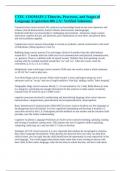CTEL 1 DOMAIN 2 Theories, Processes, and Stages of
Language Acquisition 006 || A+ Verified Solutions.
Constructivism correct answers We construct our knowledge based on our own experience and
schema. (Social Interactionist, Social Cultural, Interactionist, Interlanguage)
Students build their own knowledge in challenging environments - Responses shape content
instruction, students discuss, ask questions, give explanations to each other, and present ideas
and solve problems together.
Cognitivism correct answers Knowledge is viewed as symbolic, mental construction in the mind
of individuals. (Metacognition, CALLA)
Babbling Stage correct answers Two sub-stages: Birth to 8 months when the child imitates
sounds & 8 - 12 months when the child uses vocal communication and physical communication,
i.e., gestures. There is a definite order of speech sounds. Children first start speaking vowels,
starting with the rounded mouthed sounds like "oo" and "aa". After the vowels come the
consonants, p, b, m, t, d, n, k and g.
Holophrastic (one-word stage) correct answers Child uses one word to mean a whole statement
ex. PLAY for I want to play now.
Two-Word Stage correct answers When child reaches 2 years and begins using two word
utterances such as "car go" and use of single modifiers "that dog" adding a suffix "baby sleeping"
Telegraphic Stage correct answers Mostly 3 - 4 word sentences. Ex. Cathy Build House (is seen
in a telegram; containing just enough information for the sentence to make sense) vocabulary
expands from 50 words to up to 13,000 words -
cognitive processes involved in synthesizing and internalizing language rules correct answers
memorization, categorization, generalization and overgeneralization, metacognition
Basic Interpersonal Communication Skills (BICS) correct answers Students use this language on
the playground and with friends. It is less cognitively demanding and develops 6 months to 2
years after arrival in the U.S. Participants provide feedback to one another and the situation itself
provides cues that further understanding.
Cognitive Academic Language Proficiency (CALP) correct answers listening, speaking, reading
and writing in academic content areas. This requires the use of cognitive skills (explaining,
comparing, analyzing, etc.) and can take 5-7 years to develop
Strategies of CUP correct answers It is very important that students be encouraged to continue
their native language development. When parents ask about the best ways they can help their
child at home, you can reply that the child should have the opportunity to read extensively in her
own language. You could suggest that parents make some time every evening to discuss with
their child, in their native language, what she has done in school that day: ask her to talk about
, the science experiment she did, question her about her understanding of primary and secondary
sources of historical information, have her explain how she has solved a math problem etc.
Common Underlying Proficiency correct answers "Conceptual knowledge developed in one
language helps to make input in the other language comprehensible." If a child already
understands the concepts of "justice" or "honesty" in her own language, all she has to do is
acquire the label for these terms in English. She has a far more difficult task, however, if she has
to acquire both the label and the concept in her second language. L1 and L2 have shared
foundations and the proficiency of one language leads to the proficiency of the next language
learned.
Context-Embedded Task correct answers the student has access to a range of additional visual
and oral cues; for example he can look at illustrations of what is being talked about or ask
questions to confirm understanding
Context-Reduced Task correct answers listening to a lecture or reading dense text, where there
are no other sources of help than the language itself
Strategies of BICS/CALP correct answers If teachers have an awareness of the likely difficulty
of a task, based on Cummins' model, they can judge its appropriateness for the non-native
speakers in their classes and in this way avoid much frustration. This does not mean, however,
that ESL students should be fed a diet of cognitively-undemanding tasks. It may be beneficial to
use such activities in the student's early days at school, in order to build confidence, or as a lead
in to a more challenging activity. However, teachers should switch soon to tasks that engage the
students' brains, making these tasks accessible by providing visual or other support. Once
students are comfortable with these kinds of activities, they can be gradually exposed to tasks
that are both cognitively-demanding and context-reduced.
Overgeneralization correct answers the process of extending the application of a rule to items
that are excluded from it in the language norm, as when a child uses the regular past tense verb
ending -ed of forms like I walked to produce forms like *I goed or *I rided.
Sequential Bilingualism correct answers is when the child acquires the second language(s) after
having considerably learnt the first language, for example when the parental tongue is different
than the main language of the community or education system
Simultaneous or Multilingualism correct answers is when a child acquires two (or many)
languages simultaneously, for example when they are raised by parents speaking more than one
language.
Grammar-Translation Methodology correct answers When people first started to learn language
and grammar, it was drilled with methods of repetition and memorization. This is still seen today
when the main goal of instruction is reading and grammar knowledge of the second language.
Pro: clearly defined goals/measurable results Con: little choice/no interaction




